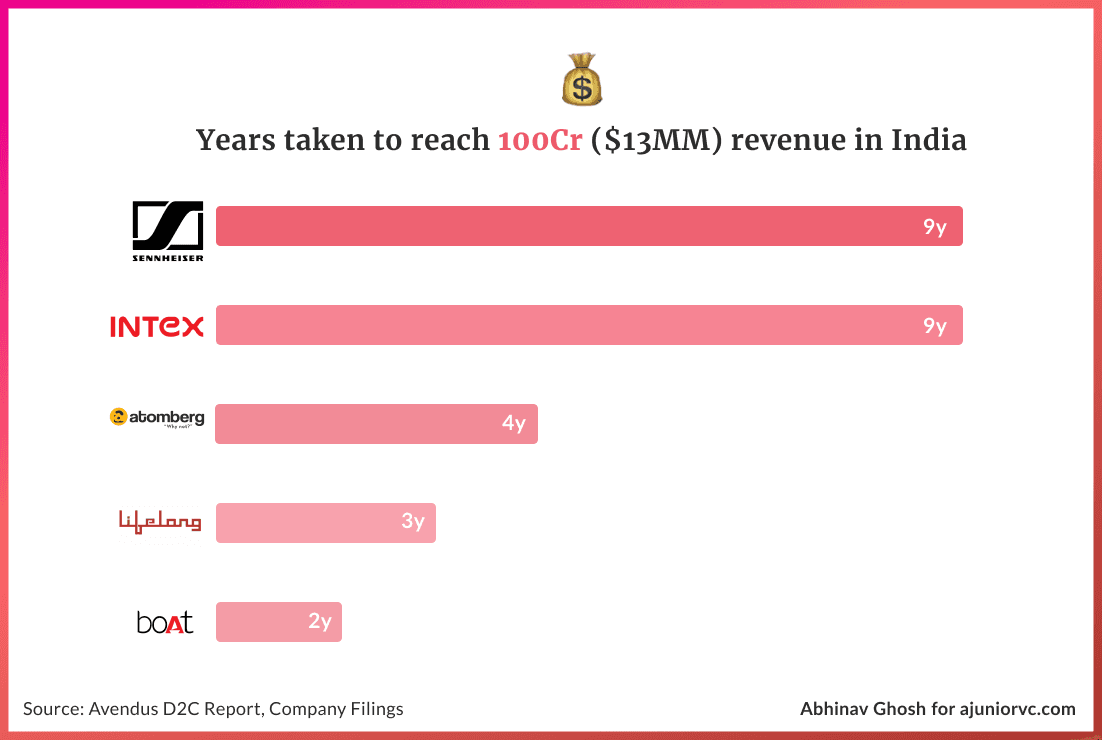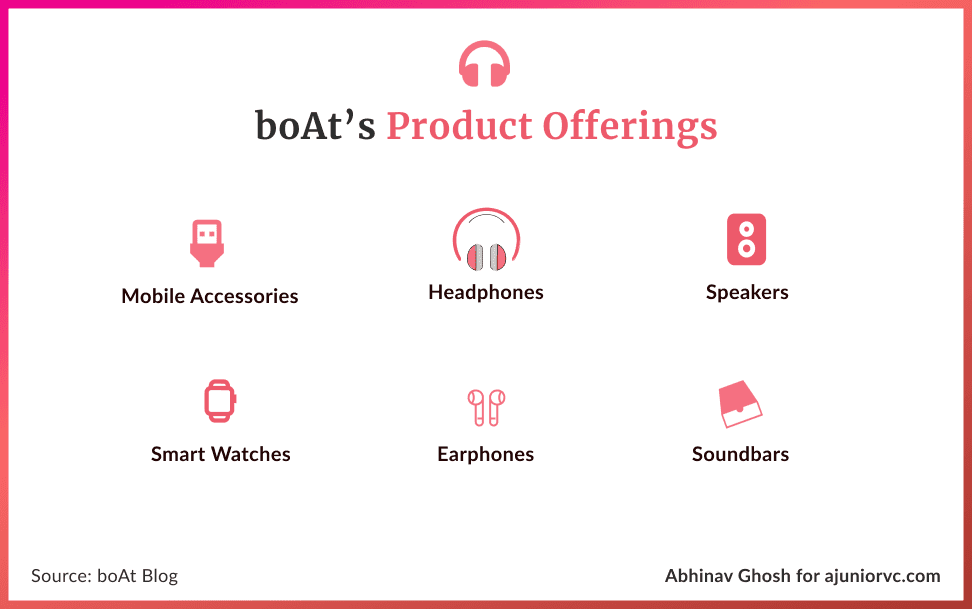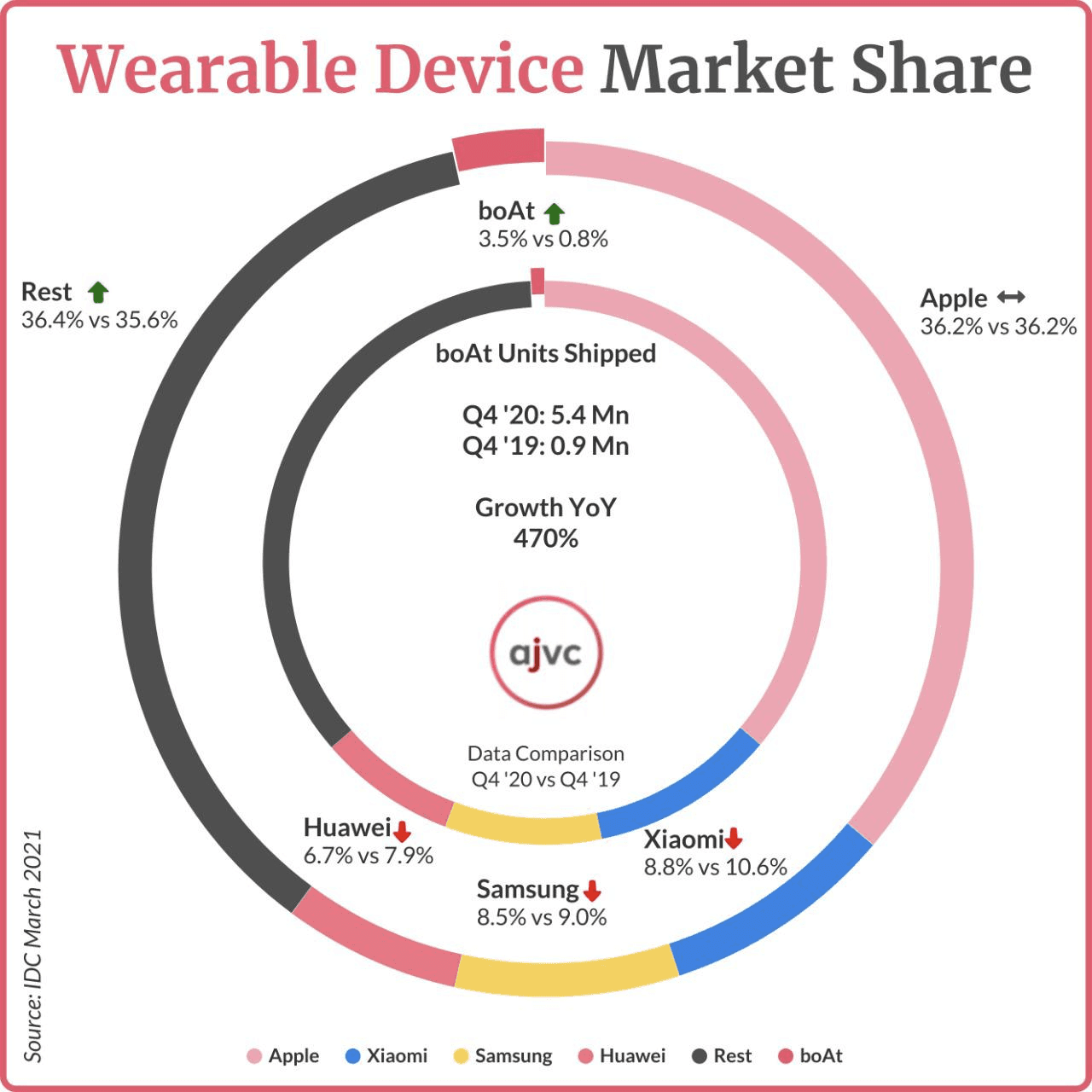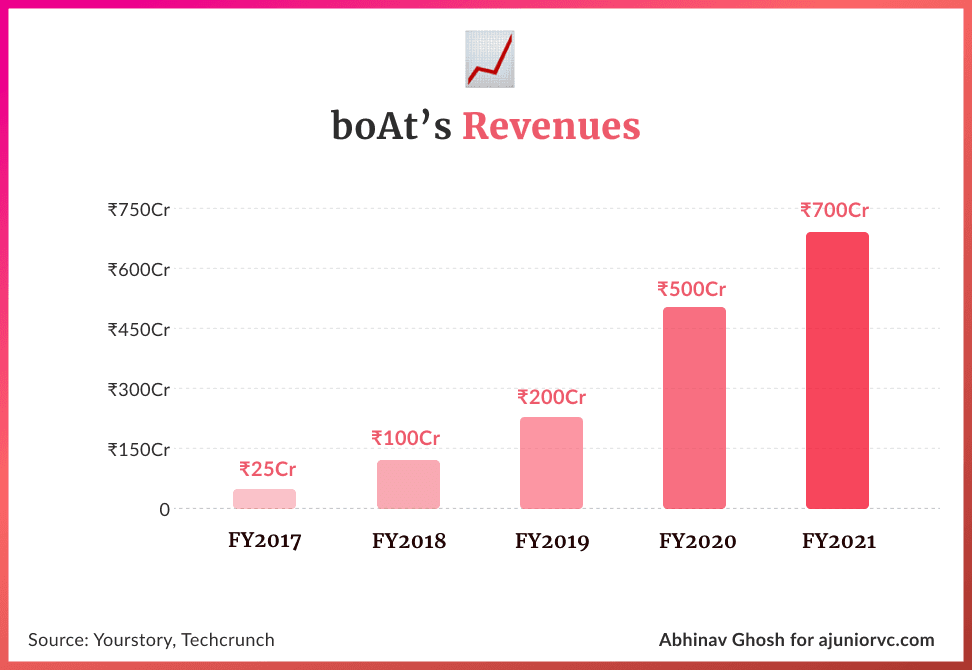
Apr 18, 2021
Will boAt Ride the D2C Wave to Unicorndom?
Profile
Electronics
Retail
Entertainment
Brand
B2C
Series B-D
Last fortnight, D2C wearables company boAt announced a ₹50cr (~$7MM) fundraise from the venture arm of a global technology company, on the heels of a ₹750cr ($100MM) fundraise.
Dropping the Anchor
Aman Gupta had been looking over his family electronics business for 3 years starting from 2007.
After completing his MBA, he quit his job at a globally reputed auditing firm in just 6 months to pursue his fascination for gadgets and electronics.
He contacted JBL expressing his wish to work for them, and looked after the offline distribution of JBL products at retail stores like Croma and Reliance Digital for a few years.
Using his experience at JBL to identify trends in the audio space, he hypothesized that even though audio was crowded with legacy players, people were willing to take a chance on new entrants in the market.
Consumers were ready to embrace new brands who challenged the gatekeepers with products like tangle free earphones and damage free charging cable.
He joined forces with another audiophile, Sameer Mehta, with the goal of redefining Indians’ relationship with music.
But Aman and Sameer were aware that India did not need another consumer electronic brand. They knew that they had to play at an intersection of the diverse product spread that already existed.
After two years of research and product exploration, they launched a headphone brand that would go to market as a lifestyle accessory brand. It would touch the unique aspects of both a consumer electronic brand and new age digital experience.
The thesis was clear - create high quality products at an affordable price, and build a community around the user base.
boAt was ready to sail.
Watch the AJVC team discuss the piece Behind the Scenes
Leaving the Harbour
The audio hardware industry was going through an interesting time around 2016.
A number of players - JBL, Bose, Bragi, SkullCandy, Jabra, Sennheiser, Sony, Audio Technica - had all seen an evolution in their offerings, over the years.
These companies had done all that was possible to stand the test of time.
From chunky over-the-ear headsets to colorful in-ear designs to comfort-adding silicon buds.
Since the last decade, they migrated to fully wireless earphones.
boAt used these prior developments from industry stalwarts and put their own spin on the product experience.
Customer obsession sounds like a cliche but it is so for a reason. boAt seems to have adopted this mantra from their very first product.
Unbeknownst to many, boAT’s first product were sturdy cables for iPhone charger.
These sturdy cables made with Kevlar fiber were meant to solve the evergreen problem of wires breaking and getting damaged easily.
boAt’s portfolio of products evolved rapidly, but using cables as a hook to get into the market was clever
They considered Millennials and GenZ at the core of their target market.
According to the founders, Millennials like buying good looking accessories that are low priced but also tend to upgrade in every few months.
Following a two pronged approach for customer acquisition, the first step is to create a new category of hearables by making a potential consumer aware of better ways of experiencing an audio device.
The second step is to then grow this category by exposing the user to a boAt way of life.

According to the startup, the strength of the product and user experience is the key to a happy boathead.
What’s a boathead, you might ask.
All the millennials buying boAt products are called boAtheads. boAtheads is a growing community with around 80k active members, continuously growing with a new boAt product being bought every 3 minutes.
boAt was making waves.

Picking Up Speed
boAt’s timing of entry into the market could have played out in favor or against them.
In 2016, many Chinese companies were entering the Indian headphone market after seeing the boom in smartphone sales.
But rough skies make good pilots.
boAt stayed laser focused on their consumers, sometimes spending days on end working with manufacturers to get the product right.
Their first audio product was bass heavy, for the simple consumer insight that indian consumers like that punchy, groovy sound. The bass heavy sound is part of our culture - dhols and tablas come to mind.
The second strategy to compete was to say no to price wars. They lie somewhere between mid-range and premium. The brand likes to refer to themselves as the ‘Zara of Electronics’.
Another competitive advantage early on was that they decided to go fully D2C in their first year.
This direct line with their customers emphasised their focus on quality and held the product to a high standard in the face of consumer reviews.
Upon receiving positive early traction, the company hit the accelerator.
By analyzing purchasing pattern trends, they realised that consumers are increasingly looking for headphones and devices that they could use while running or playing sports.
Shortly, they launched fall proof earphones in different pleasing color ranges. They even entered the wearables market with the launch of a smartwatch.
The company recorded a revenue of INR 25 Cr in its first year of operations, and 4x’d to INR 100 Cr in its second year.

This was a solid base to verify the thesis that Aman and Sameer had - India’s gap in this market. A gap of a ‘desi’ everyday fashionable brand that people could associate with, at affordable prices.
The product market fit had been achieved, and it was time to rev the engines.
Come for the Tech, Stay for the Party
Creating an affordable successful consumer brand isn’t possible without spending heavily on brand awareness, advertising and a wide-spread retail footprint.
But today, this well-trodden path of establishing a brand can be bypassed if one knows how to harness the immense power that lies within a tech-savvy ‘community’.
India is the 2nd largest when it comes to its 700MM+ internet users and 142nd when it comes to GDP. boAt saw this crossroad with a unique community-based approach.
Calling every user a “boAthead” made users belong to a community where they can share their lifestyle aspirations at not so premium price point but a premium feel.
The want to become a boAthead was aggravated among the potential customers when the much-coveted cricket stars and young Bollywood celebs jeweled themselves with boAt products.
Hardik Pandya, Shikhar Dhawan, Rishabh Pant from cricket and Kartik Aryan, Kiara Advani, Diljit Dosanjh, Neha Kakkar from Bollywood are some of the boAtheads who have been key in promoting the brand.

boAt, unlike traditional consumer electronic brands, also makes its potential consumers inclusive through its content blog.
The pieces are written not just to promote but also in a way to educate the readers on which products are best for them.
This way of advertising proved to be successful, and this is substantiated by an impressive 150% growth in the #IAmABoathead community base in the last two years.
Everyone’s Got a Spot on Board!
boAt has a presence across a wide and diverse set of categories.
The company has been able to get into multiple categories with a commendable speed.

This was made possible as boAt’s supply chain, manufacturing and R&D efforts were well integrated in China.
But when the pandemic hit, rising international tensions started affecting boAt’s manufacturing.
And given the core value prop inherent in all of its products – affordability, it couldn’t shift the manufacturing to any other country quickly.
Despite this biggest hindrance, boAt has come up with an extended product launch plan including gaming peripherals such as joysticks, headsets, gaming mice and keyboards.
This became possible as the founders navigated a way to expand R&D in India and promote local manufacturing.
The market conditions and regulations also started being conducive for the ‘Make in India’ approach and boAt was well placed to take advantage of the Production Linked Incentive Scheme (PLI) promoted by the Indian government.
Not every company is suitably placed to benefit from the scenario, but because boAt has been built profitably with sustainable principles in its war chest, it was ready to create a kingdom.
You Jump, I Jump
boAt adopted a unique approach to marketing.
Scaling via partnerships with not only the homegrown talents but also homegrown events proved to be successful in expanding the Boatheads community.
Customizing their products according to latest trending jazz for the likes of Lakme Fashion week, IPL, and Sunburn made the brand always relevant and creates a high recall in the consumers’ mind.
boAt has showcased immense agility in terms of quickly planning for, creating, marketing and distributing new designs to the existing products suitable to different tastes and also occasions.
There is a lifestyle feel associated with walking into Wankhede, flashing on the Mumbai Indians earphones.
boAt has also come up with an exclusive line of products with Masaba.
Operating like a co-brand, and products customized with a boAt * Masaba logo mixed with the cutting-edge audio, the brand is definitely creating excitement.
In addition to the ‘pull’ they receive from customers, boAt’s growth has been multiplied by distribution partnerships with the likes of e-commerce players like Amazon and Flipkart.
To engage further with the community, they built relationships with offline avenues like Croma, and even tested shop-in-shop concepts to give potential buyers an ‘immersive experience’ of its products.
People wanted to party, and boAt was making that possible.
Avoiding Icebergs
boAt’s rise in India has not been without competition.
Asia-Pacific was expected to witness the highest growth in the earbuds market, owing to the growing electronics industry coupled with a rapid rise in the disposable income in the region.
Global players like Apple, Sony, Skullcandy, JBL and Bose have all made efforts to expand into the Asia-Pac market, with mixed levels of success.
Companies were starting to realise that while software was eating the world, hardware was helping down the meal.
But multinational brands’ products were priced higher here due to the custom and excise duties, and this was the opportunity for local brands to get in on the action.
The older players were rushing to introduce advanced features, while the newer ones were finding gaps in the system based on demand and user feedback to expand their footing.
One would have to be willing to shell out 15-20K INR to buy one of Sony or Bose’s ANC devices in India.
In a price-conservative market that sees enormous spikes in purchasing activity on sale days, this number was out of range for many consumers.
There was a need to introduce an alternative with an Indian consumer friendly price point.
The battle was intense, and it was safe to say that the Indian consumer was spoilt for choice.
Manufacturers like Xiaomi (16% of TWS market share in India), RealMe (12%) and JBL (8%) expanded their range of affordable earphones, giving boAt stiff competition.

But boAt rode the wave.
The myriad of options that boAt offered stood out as ways to flaunt one’s personality, and they were an instant hit in the Indian market. And between them beginning out as accessory manufacturers to them nailing the Indian millennial consumer’s persona and tailoring their offerings accordingly, they left no stone unturned.
boAt, despite being late to the party, had conquered 18% of the market share in the TWS segment in India by the end of 2020.
Staying Afloat
By FY18, boAt was already selling 6,000 units per day, thereby budding more Boatheads in the second year of their full operations.
The company witnessed a fantastic growth for the next two years hitting INR 500 cr of revenue in FY 20, up 5x from INR 100 Cr in FY18.
There was a visible setback in the growth rate trajectory during the pandemic but boAt still outnumbered the founders’ estimates of a 30-35% growth in FY21.
What was more interesting was the jump in Average Order Value (AOV).
Boat claimed it was at a run rate of 6,000 units per day with INR 100 Cr of annual revenue in FY18, giving it an AOV of INR 457.
Fast forward three years to FY 21, it was already doing 15,000 units per day with an annual revenue of INR 700 Cr, bringing its AOV to INR ~1,300.
An increase of 2.5x+ in the AOV proves two things.
First, the strategy of incrementing the price points in small steps works.
Second, once consumers start trusting and valuing a brand that resonates, it helps the brand to make customers stick and buy other products without shelling discounts.

Diving into unit economics, research shows consumer electronics operate at 50%+ gross margins.
With a 50% GM, an AOV of INR 1,300 and conservatively assuming 50% retention in 2nd Year i.e. 1.5 products per 2 years lifetime of a consumer, we get to an LTV of INR 975.
Now since the EBITDA margin for boAt is at 7% and gross margins are at 50%, it is safe to assume that the Sales and Marketing spends could be to the tune of 25-30%.
Leaving the rest for G&A, indirect R&D and distribution. Recalling that boAt sells 15,000 units per day, it translates to total sales of 5.45M units
With a 50% retention and a customer acquisition cost of INR 640 (S&M of 25% * 700Cr / (5.45mn units * 50% new customers)), it easily breaks even on LTV / CAC.
Their income crossed 700 Cr in FY20, seeing a whopping 460% growth in profits. They bagged a $100MM investment in early 2021, pegging their valuation at roughly a quarter of a billion dollars.
This, within 5 years of launching a consumer brand, a tale to tell.
Sailing Into the Distance
Looking at the stupendous growth witnessed since its inception, there’s no doubt that boAt is going to have some incredible years ahead.
They have largely beaten their own expectations when it comes to predicted FY revenues, a trend we expect will continue.
Becoming the 5th largest wearable brand in the world in 4 short years of operation is a feat that speaks for itself. They’re just getting started.
Boat is truly paying in an exciting segment where players are creating large outcomes.
Apple, for instance, is playing in the similar market of consumer electronics but with only one few key products till now - Apple watch, Airpods. Just talking for Airpods, it is expected to have a sale of 100mn products annually at a $200 price-point.
That’s a $20Bn business for you right there.
Assuming a profit margin of 30%. Apple has 20% profits but Airpods make 15% higher Gross Margins, Airpods make $6bn in profits annually. With Apple’s P/E ratio of 20x, Airpods is a $120bn+ company!
To put in perspective, India’s top 10 most valued startups total around $70bn.
Though Boat plays at different prices but targeting more volumes, It is a humble beginning for Boat with a bright future ahead. BoAt’s secret sauce was delivering exactly and only what was required, in an aesthetically appealing manner.
As you just read, boAt’s growth story has been extremely captivating, and is among the first few Indian hardware startups that have been able to raise $100MM.
Much like BoAt’s management, we believe that the boat is just beginning to sail.
Even with Chinese retailers posing a threat by sharing the stage at boAt’s target price point and retail giants like Croma and Amazon launching their in-house private labels, boAt has maintained a steady footing in each of the categories that they have chosen to enter.
The community will be the moat, and continues to be.
While the founders believe that shifting 100% of their manufacturing capacity to India will take some time, they are eager to bring their offerings to the rest of the world as well.
boAt democratised audio technology in India, and the world awaits.
By Bhoomika, Saniya, Shelley, Abhinav, Shiraz and Aviral
Audio Version: Behind the Scenes with AJVC
We bring to you, AJVC behind the scenes podcast with your host Chetan.